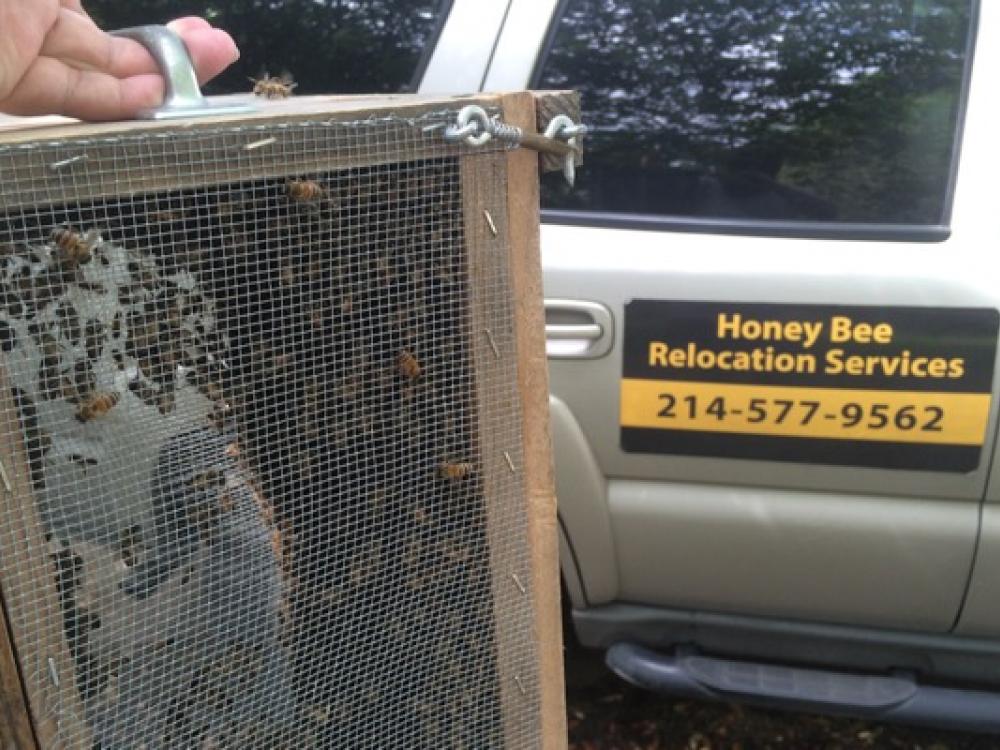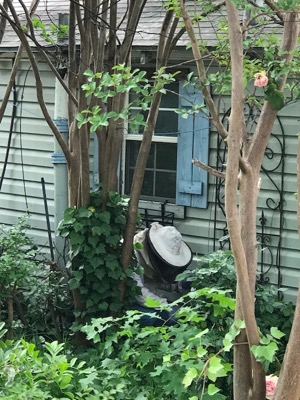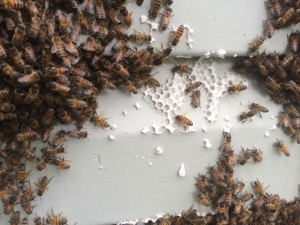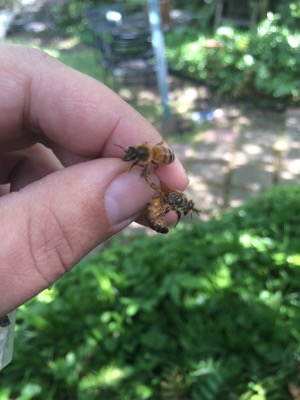
Honey Bee Relocation Services in Dallas has been endorsed by the Texas Honeybee Guild as a humane bee removal company. Courtesy of Ryan Giesecke.
June 11, 2018
Kristi Comuzzi was getting a little yard work done around her Park Cities home near SMU when she began to notice that there was something different about the sound of the outdoors. When she approached her garden shed, the low rumble she’d been hearing grew louder, and that’s when she first spotted intruders among the lush vines of English ivy growing up the side of the structure. Thousands of beige and black little bodies were furiously busying themselves with building a home. It was a swarm of honey bees, and apparently Comuzzi’s property seemed like just the right spot to start a new hive.
“I looked up and saw them heading towards my yard from the south,” she says. “I have severe allergies to wasps, bees, et cetera, so initially I was alarmed,” she says. “In less than 24 hours they had begun to form a honeycomb of wax.”
Unable to risk an allergic reaction, Comuzzi wanted to get rid of the bees quickly and thoroughly, but she didn’t want them to be harmed. Eco-conscious and host of a radio talk show that explores sustainable lifestyle options, she knew the value of pollinating insects and how bees and butterflies are in decline all over the world.
“Even though I am extremely allergic, I am a big big fan of the bee,” Comuzzi says. “I have done numerous interviews on my talk show Shootin’ the Breeze about the wonders and benefits of bees in our world, that I would never seek to harm them. Roughly one sixth of flowering plants and 400 agricultural plants on this planet rely on pollination from bees. Aside from helping to beautify the world, bees are responsible for a huge range of foods we rely on daily: broccoli, asparagus, cantaloupes, cucumbers, pumpkins, blueberries, watermelons, almonds, apples, cranberries and cherries.
“I went immediately inside and started trying to find a good bee company, and that was when I realized this is not easy to do. Many claim to be safe; some do not have any mention of costs, so you get a sense it could be rather costly. I came to find out that a few companies out there claiming to be pesticide-free or removal companies are actually licensed pest control companies, and some even advocate killing bees, though this was not apparent via their website.”
BEE-WARE
From a quick search online, Comuzzi found that bee eradication services are big business, and that hiring an unscrupulous pest control company posing as a bee-friendly service presented an even greater risk when they kill off the bees with insecticides, because as long as they’re alive, the bees that work their way into a structure keep their hive maintained and tidy.
"I came to find out that a few companies out there claiming to be pesticide-free or removal companies are actually licensed pest control companies, and some even advocate killing bees, though this was not apparent via their website.”
“The minute you seriously disrupt that hive, kill the workers, and use pesticides, that management breaks down,” she says. “The carefully maintained hive, now unmanaged, results in honey no longer being inside that honeycomb and dripping down inside the walls. This is a result that is not talked about. That honey drips and destroys the structure, and then vermin and pests are attracted to that honey, all the while it is rotting out the wood. And the expense of dealing with that can be enormous.”
Head of the Austin-based American Honey Bee Protection Agency, Walter Schumacher knows all too well the scenario Comuzzi describes. He says in his 12 years of experience helping homeowners and building managers resolve their bee issues, he’s come across many frustrated homeowners who say they were duped by pest control companies posing as beekeepers and charging exorbitant fees for killing bees they claim were unable to be relocated. Some pest control companies, he says, are guilty of outright fraud.
Walter Schumacher of American Honey Bee Protection Agency in Austin says many frustrated homeowners say they were duped by pest control companies posing as beekeepers and charging exorbitant fees for killing bees they claim were unable to be relocated.
“They have entire divisions now devoted to bees,” Schumacher says. “They call you and say they’re X Y Z Bee Service, and then they tell you they’ll be out there for X amount of dollars. And then they show up, and they stir the beehive up as they're in their bee suits and they're protected. And they come and knock on your door and tell you, ‘Hey. These are Africanized bees. We’ve got to kill them.’”
Schumacher says that despite the easier task of killing bees with insecticides, the pest control companies will often charge more than a bee relocator, simply because the homeowner is ill informed and anxious to have the problem resolved. As the pest control company is onsite with an immediate solution to the problem, the homeowner is susceptible to their sales pitch.
“They have entire divisions now devoted to bees,” Schumacher says. “They call you and say they’re X Y Z Bee Service, and then they tell you they’ll be out there for X amount of dollars. And then they show up, and they stir the beehive up as they're in their bee suits and they're protected. And they come and knock on your door and tell you, ‘Hey. These are Africanized bees. We’ve got to kill them.’”
“And so they spend five minutes and end up charging three times what they originally agreed to charge because now, it’s an extermination,” Schumacher says.
Killing bees in a structure, however, does not spare the need of opening up walls and entering the attic or crawl space to remove the honeycomb just as a bee relocator would do, says Schumacher. If the honeycomb is left in the structure, either additional bees will be attracted to the site or the structure will suffer an invasion of pests.
“Nobody knows the size of a beehive in the wall unless the wall is actually opened. Let’s say it’s a two-foot by two-foot beehive, if it’s not removed, now you’re feeding thousands of cockroaches, silverfish, rats - anything that eats that sugary substance,” Schumacher says. “A revolving door has just been created for the pest control company to come back out later on.”
Schumacher says the majority of online listings for bee removal services are merely pest control companies in disguise. Comuzzi says she was tipped off to the imposters by a simple, easily overlooked detail they listed on their websites: their pest control license.
“A bonafide, safe bee removal company will not typically also have a pest control license. A pest control license might be a tip off that this is not a 100 percent bee-friendly company,” Comuzzi says.
BEE WHISPERER
 After she was alarmed by the online search results she found, Comuzzi took her quest to social media and asked her eco-conscious friends for advice, which is how she came to find out about the Texas Honeybee Guild, which ultimately referred her to Ryan Giesecke of the totally bee-friendly business, Honey Bee Relocation Services. Comuzzi says Giesecke responded to her call within an hour and so she chose him for the job.
After she was alarmed by the online search results she found, Comuzzi took her quest to social media and asked her eco-conscious friends for advice, which is how she came to find out about the Texas Honeybee Guild, which ultimately referred her to Ryan Giesecke of the totally bee-friendly business, Honey Bee Relocation Services. Comuzzi says Giesecke responded to her call within an hour and so she chose him for the job.
Ryan Giesecke of Honey Bee Relocation Services checks out the bees clustering in a Dallas yard. Courtesy of Kristi Comuzzi.
“Kristi's rapid response to seeing bees in the yard resulted in my arrival prior to the colony actually moving into a structure,” Giesecke says. “They were sitting in a cluster in a trellis on the wall to her backhouse. Since bees without an established home to defend are especially docile, I was able to literally scoop handfuls of bees gently into a box until I located the queen. I confined the queen to a queen cage temporarily, placed her in the box, and her workers simply followed her inside.
“Having left Kristi's place in a well-vented temporary container, the bees were then moved into standard beekeeping gear at my home. They were given some established comb from a larger hive to help them get started and were fed supplemental honey until they were established in their new home. Soon they will be moving out to one of our beeyards in the Royce City area, where they will remain in our management long enough to help produce another productive new hive. In the long run surplus bees from our removals are made available to other members of the local beekeeping community.”
Giesecke says he relies on careful disassembly when he needs to reach honeycomb within a structure, which often reveals a beehive weighing in at a total 150 pounds or more. Each removal requires its own, unique strategy, and extermination is never an option. This approach works for every one of the 100 or more hives he removes each season.
 “We always choose the gentlest removal approach possible for the bees, which generally means an approach centered on convincing the workers to move rather than collecting them by force. This was especially feasible at her home where they were not firmly established; but, even if they had been, it would simply have meant that we had to access the comb and move it into the box first,” Giesecke says.
“We always choose the gentlest removal approach possible for the bees, which generally means an approach centered on convincing the workers to move rather than collecting them by force. This was especially feasible at her home where they were not firmly established; but, even if they had been, it would simply have meant that we had to access the comb and move it into the box first,” Giesecke says.
A honeycomb is progress. Courtesy of Honey Bee Relocation Services.
“We always choose the gentlest removal approach possible for the bees, which generally means an approach centered on convincing the workers to move rather than collecting them by force."
 Comuzzi says that within 24 hours after noticing them, the bees were all gone, and her cost was well under $100. She says she’s put Giesecke’s phone number on speed dial in case she ever has a bee problem again.
Comuzzi says that within 24 hours after noticing them, the bees were all gone, and her cost was well under $100. She says she’s put Giesecke’s phone number on speed dial in case she ever has a bee problem again.
“All that remains is the honeycomb of wax that the bees started,” She says. “I was very impressed that unlike the other companies I had called, Ryan has an infrared camera that he uses to see through walls in a structure to see if there are hives inside, which is extremely helpful, as the other guys were just going to start taking apart my eaves. And then you have to rebuild that torn out structure. It’s way better to first check that a hive is actually inside the structure. Ryan said he would come back to my house to check the garden shed walls, but he felt he got the entire group. He for sure got the queen as he showed her to me.”
Courtesy of Honey Bee Relocation Services.
Now Comuzzi says she’s spreading the message about the right way to remove bees, to help people to make an educated and informed decision to find a good reputable bee friendly, safe bee removal company.”
“That is what I noticed was so lacking,” she says. “You don't just Google it and find it because many pest companies have become pretty sophisticated in developing robust websites and describing their services as safe or friendly relocation services, and they pop up first on a Google search.”
BEE RESOURCES
Whether a feral hive of honey bees sets up in a hollowed out tree in your backyard or in the attic of your home, you’ll want to act fast to get rid of them, or their removal costs will escalate. But, locating a reliable bee removal service that’s honest about what they charge and focused on caring for the bees rather than exterminating them can be a challenge. Coming to the rescue of bee-troubled homeowners and property managers are several organizations that say they can help with just about every bee issue that arises.
In North Texas, Susan Pollard of the Texas Honeybee Guild strives to promote the well-being of bees and pollinator habitat. She fields calls throughout the bee migration season and offers referrals to bee relocators who share her values for protecting bees and never using insecticides. She says the most important qualifier to look for when choosing a bee relocation service is to “first choose and support local beekeepers that have chosen rescue and relocation as their primary source of income.” Honey Bee Relocation Services and Harmony Hollow Apiaries in Dallas are both endorsed by the Texas Honeybee Guild.
Trinity Valley Beekeepers Association.
Ryan Giesecke is owner of the totally bee-friendly Honey Bee Relocation Service based in Dallas. His company removes about 100 hives each season, and when Giesecke’s workload reaches capacity, he can offer a referral to any of his colleagues as he’s also head of the Trinity Valley Beekeepers Association, which sends out beekeepers to remove unwanted bees at properties throughout the region.
For anyone who searches online for help with a bee problem, Giesecke says, “Contact a beekeeper experienced in live removals who can talk you through the situation. Beekeepers are not licensed for insecticide usage and have every motivation to find a solution that works for both the homeowner and the bees. Do not rely on an assessment by someone who offers to spray the colony, even if they also claim to offer live removals, as the availability of the lethal option may leave them less inclined to consider all options for proper live relocation.”
American Honey Bee Protection Agency
The American Honey Bee Protection Agency is a non-profit organization on a mission is to help Texans choose no-kill methods for bee removal. The organization helped to get the honey bee declared the official pollinator of Texas and has been instrumental in passing ordinances that prioritize no-kill bee removal methods in Austin. Its head, Walter Schumacher, says he offers referrals for safe bee relocation services throughout Texas, including areas around Dallas and Fort Worth. The organization accepts donations for bee removal from a property, but for anyone who’ unable to pay, services can be rendered free of charge after a little paperwork.
Schumacher says he’s confident his organization can put anyone in the state in touch with just the right service to handle a bee problem, but for anyone who seeks out a service on their own, his tips on locating a legitimate bee-friendly bee removal service are stringent:
Ask for proof insurance.
Schumacher says anyone can claim to be a bee relocator as the industry is unregulated. Proof of liability insurance often distinguishes the professional from the amateur or scammer.
Ask where the bees are taken.
“Ask if you can come see their apiary,” Schumacher says. “If they’re really removing the bees and keeping them alive, they’ve got to put them somewhere.”
Get an estimate for how long it will take.
“If anyone says it takes less than two hours to do a cut out, they’re an exterminator,” he says. “If you have to actually remove bricks or remove wood to get to the beehive, then you're looking at multiple hours.”
Look for municipal vendor registration.
Schumacher says any bee removal and relocation specialist who’s not registered to provide services to at least one city may be questionable.
Ask for a contract.
Schumacher says honest, no-kill bee removal specialists will be willing to put in writing that they’ll not use insecticides and that the bees will be kept alive.
And for those who are convinced they can handle a beehive themselves with a bottle of insecticide, Schumacher has a word of caution that equally applies to anyone trying to coexist with a feral hive that's too close for comfort.
“Let’s say it’s a big beehive with a quarter of a million bees,” he says. “That queen will send out multiple flights of ten percent of the hive to attack you. To the bees, you're a bear trying to steal their honey, so they’re going to send out about 2,500 bees to deal with you. That spray that you spray at the front of their hive, that might wipe out a couple thousand of them, but you as a human can only be stung 1,500 times before you’re dead.”
Stay up to date on everything green in North Texas, including the latest news and events! Sign up for the weekly Green Source DFW Newsletter! Follow us on Facebook and Twitter.









